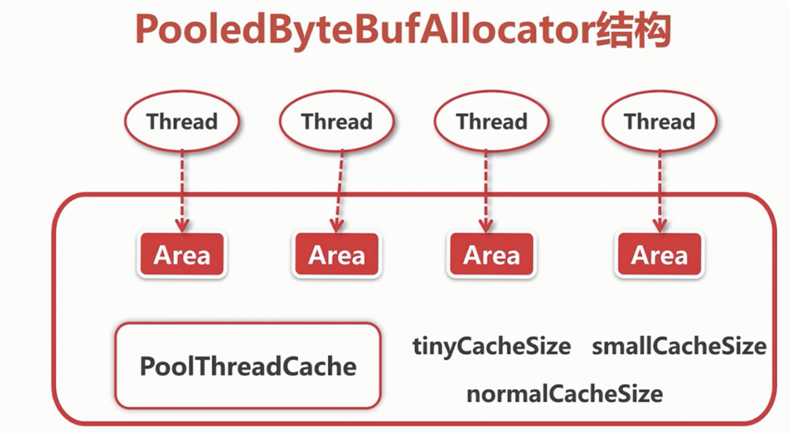标签:创建 大于 地方 led bsp write mic 内存分配器 dex
ByteBuf直接与底层IO打交道
1、内存类别有哪些
2、如何减少多线程内存分配竞争
3、不同大小内存是如何分配的
内存与内存管理器的抽象
不同规格大小和不同内存类别的分配策略
内存回收
ByteBuf结构
readerIndex,表示要读数据从当前指针开始读,从0到readerIndex这段空间表示是无效的
writerIndex,必须大于readerIndex,表示要写数据从当前指针开始写,从readerIndex到writerIndex这段空间表示可以读的
capacity,必须,从writerIndex到capacity这段空间表示空闲可以写的
ByteBuf API
read,从readerIndex往后开始读
write 从writerIndex往后开始写
set 不移动任何指针,直接再当前指针地方进行设置
markReaderIndex 将readerIndex进行保存起来
resetReaderIndex 将readerIndex进行恢复,这样读数据就不会移动指针
markWriterIndex 同上
resetWriterIndex 同上
readableBytes() writerIndex - readerIndex
writeableBytes() capacity - writerIndex
ByteBuf分类

Pooled和UnPooled,内存分配时从已经分配的一块内存中分配一块,有预分配过程,UnPooled就是直接向操作系统申请内存
Unsafe和非UnSafe,Unsafe可以直接拿到内存地址,可以直接拿到ByteBuf在JVM内存通过内存地址和偏移量,非unsafe可以直接调用jdk api读写,通过数组和下标访问数据,。jdk自动判断Unsafe或者非Unsafe
Heap和Direct,在堆上直接分配,jc自动回收管理,依赖一个数组,Direct调用jdk api分配不会被jvm内存回收管理,依赖jdk底层的ByteBuffer。
ByteBufAllocator 内存管理器
AbstractByteBufAllocator骨架实现
UnPooledByteBufAllocator,直接分配一个容量大小的数组
newHeapBuffer 在堆上new一个数组出来传入并保存
newDirectBuffer 依赖于jdk底层ByteBuffer,保存初始地址和容量。
PooledByteBufAllocator,首先拿到线程局部缓存,PoolThreadCache先创建PoolArena<byte[]>,PoolArena<ByteBuf>这两种内存池,在线程上的Arena上进行内存分配。创建内存分配器时会创建两种类型的数组,PoolArena.HeapArena和PoolArena.directArena
newHeapBuffer
newDirectBuffer

标签:创建 大于 地方 led bsp write mic 内存分配器 dex
原文地址:https://www.cnblogs.com/xiaofeiyang/p/12688010.html